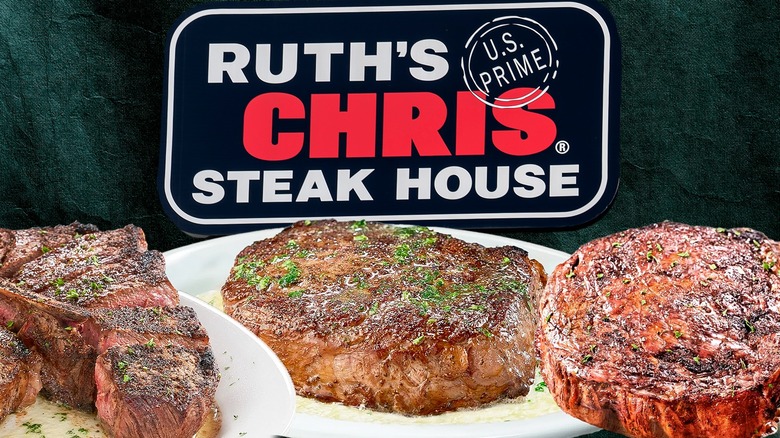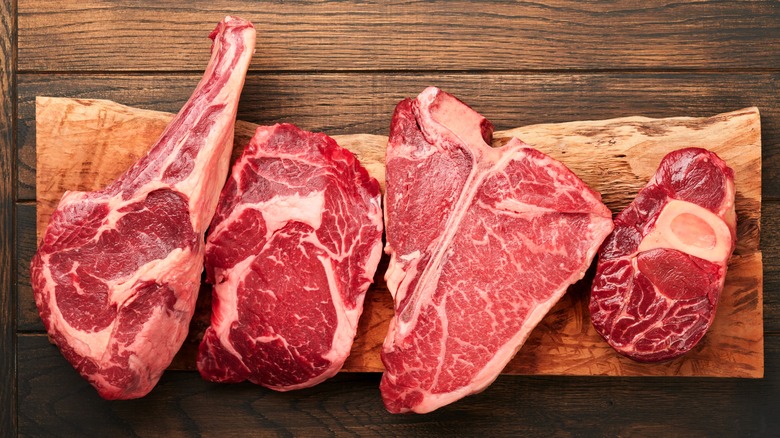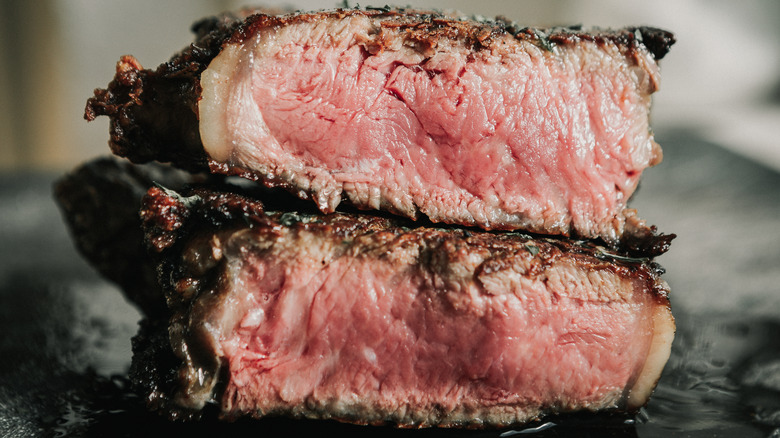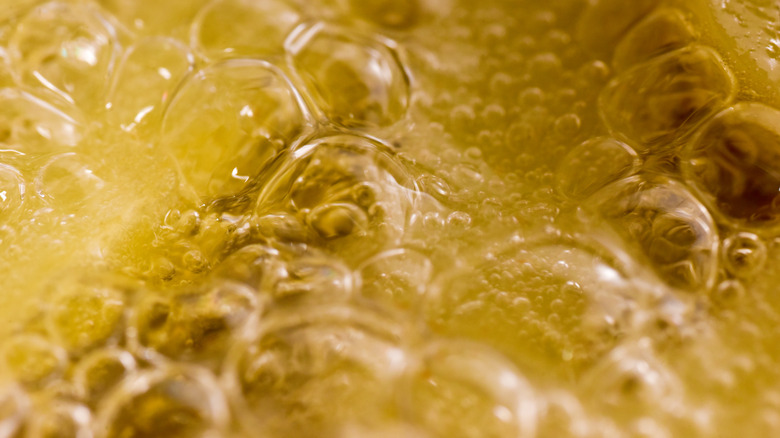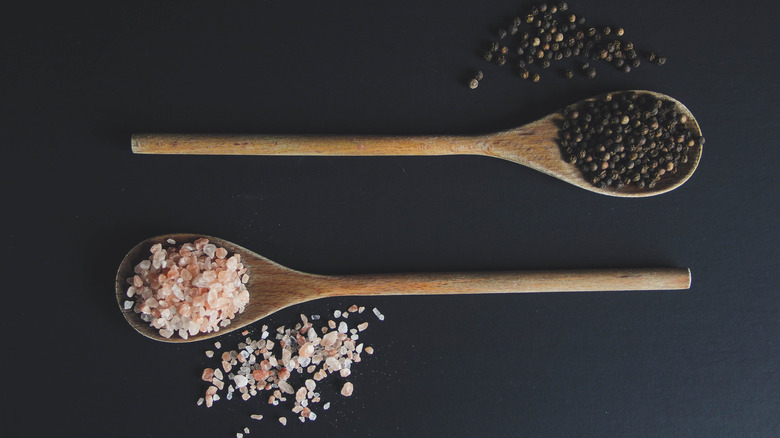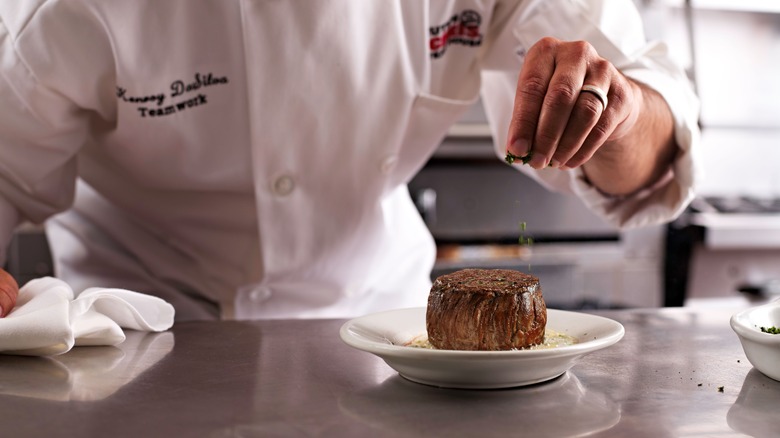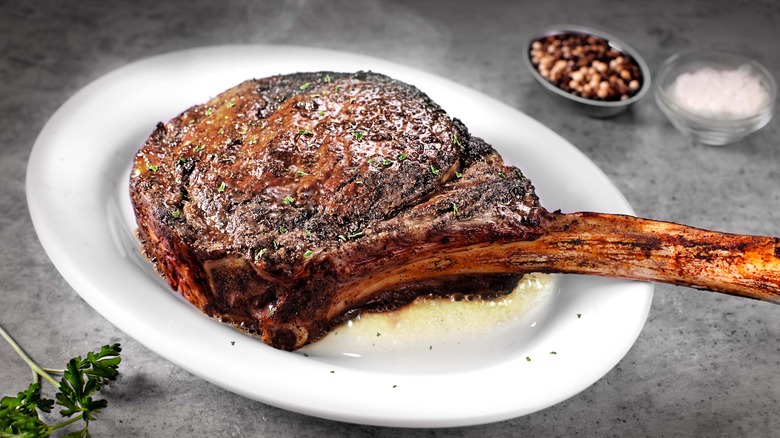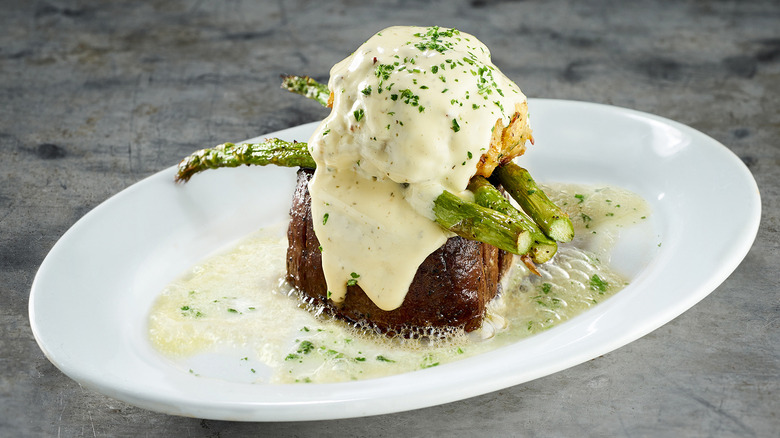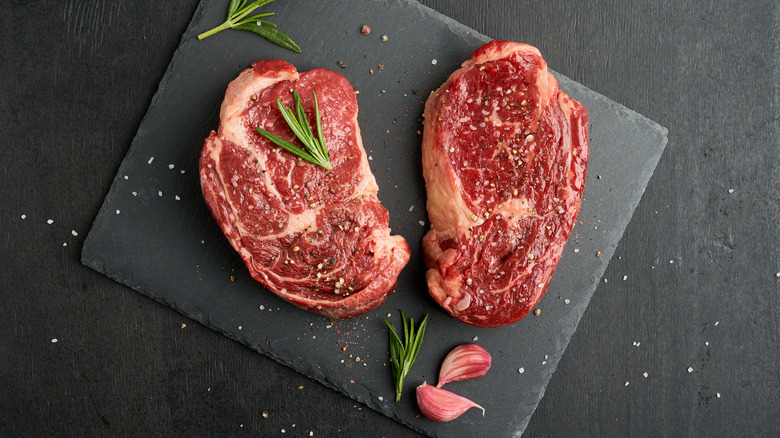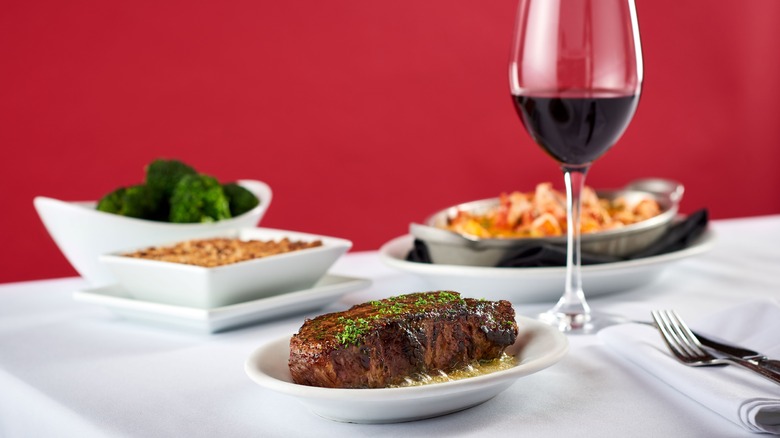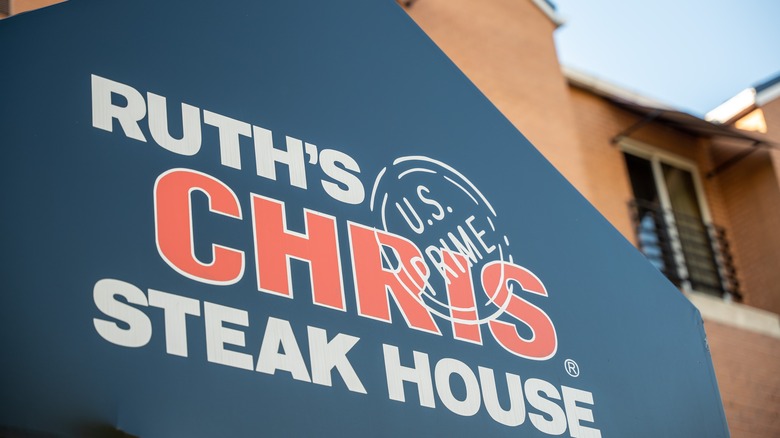Why Ruth's Chris Steaks Always Taste So Good
When Ruth Fertel bought Chris Steak House in New Orleans in 1968, she had no plans to turn the modest eatery into a global icon among steakhouses. All the recent divorcee wanted was a steady income stream that would allow her to put her two sons through college. Despite her lack of experience in restaurant management, she proved to have a natural talent for it. Her restaurant developed a loyal following –- so much so that a superfan who was moving out of town proposed to open a franchise to continue enjoying Fertel's steaks near his new home.
This was the start of Ruth's Chris' rise into the steakhouse big leagues. Today, diners around the world in the mood for a splurge know they can rely on Ruth's Chris to deliver blazing hot, yet meltingly tender prime steaks along with generously portioned sides and desserts, some based on Fertel's family recipes. The steaks, of course, are the star of the show at Ruth's Chris, which prides itself on the quality of its meat and its unique cooking and presentation methods. We talked to Abdiel Aleman, the executive chef at Ruth's Chris and a 30-year veteran of the restaurant, to get an insider's perspective on what makes its steaks so special.
Prime steaks make a big difference
A plain cooked steak may be the simplest of dishes — just a steak and maybe some salt and pepper –- but that doesn't mean it's easy to make well. If you mess up, the meat has nowhere to hide, and your shortcomings as a cook will be immediately obvious to the diner. One of the ways you can mess up before you set foot in the kitchen is by starting with a poor-quality steak. Ruth's Chris doesn't take this chance. "We proudly serve fresh, never frozen USDA prime and choice beef from across the United States," Abdiel Aleman said. "Ruth's Chris primarily uses beef from states where 70%of the cattle industry is based, including Nebraska, Oklahoma, Iowa, Kansas, Colorado, Texas, South Dakota, and Florida."
Prime is the top rating on the USDA meat grading scale and indicates the highest level of tenderness and marbling –- only 2% of beef qualifies as prime. This is why we rarely see it in supermarkets: Restaurants and specialty purveyors snatch almost all of it up first. As a result, its reputation as rare and pricy is well-earned — and you should expect to pay a premium to enjoy it.
Special broilers cooks steaks quickly
Steak lovers all have their own favorite ways to cook their meat just to their liking. To get her steaks exactly the way she liked them, Ruth's Chris founder Ruth Fertel held a degree in chemistry and a minor in physics and worked as a lab technician before buying her first restaurant. She brought this expertise in the physical sciences to the kitchen and developed a proprietary broiler, which the restaurant continues to use to make its steaks.
The super-heating infrared broiler, which reaches temperatures up to 1800 F, cooks steaks to perfection in a flash. Because this device is unique to Ruth's Chris, even experienced chefs who've mastered other methods of steak cookery require special training to use it. For Ruth's Chris cooks, it's a constant learning process. "Our broiler is the pinnacle of the kitchen, and our broiler cooks are specially trained at their craft," Abdiel Aleman said. "To help them continue to execute at the highest level for our guests, we consistently recertify every broiler cook at Ruth's Chris."
Heated plates keep steaks hot
For those of us who eat breakfast in our cars, lunch at our desks, and dinners while racing against the clock, the opportunity to indulge in a long, leisurely meal prepared by someone else feels like a rare luxury. The only downside, as many slow eaters have discovered, is that enticingly hot entrees will go cold and lose their charm before we've had the chance to enjoy them fully.
This is unlikely to happen at Ruth's Chris. To ensure diners have a fully satisfying eating experience, the restaurant serves its steaks on heated plates — and not just gentle, just-out-of-the-dishwasher warm, either. "We serve their steak on a 500 F sizzling plate so their last bite is just as hot as their first," Abdiel Aleman said. This ensures your steak will not only arrive at your table good and hot, still crackling from the broiler, but will stay hot even if you linger over your meal. When a server at Ruth's Chris warns you not to touch your plate –- heed their warning.
Sizzling butter makes steaks smell and sound amazing
A great eating experience isn't just about flavor. In reality, our enjoyment of food is a multisensory experience –- the way food smells, looks, and feels in our mouths all play roles in how we experience what we eat. Pastry chefs, for example, know that people eat with their eyes before they eat with their mouths –- the prettiest cakes and cookies always get chosen first.
Oddly enough, even the right sounds can make our stomachs growl. Ruth's Chris founder Ruth Fertel knew this, which is why she insisted on topping every hot-from-the-broiler steak with a generous gob of butter. Not only does butter taste and smell amazing –- and form its own pan sauce as it melts atop the steak –- it even sounds tasty when it hits the restaurant's super-heated steaks and plates and starts to sizzle. Thus, it lets guests start to enjoy their steak even before it arrives at their table. "You hear that sizzle, and you think, 'I wonder if that's my steak,'" Fertel once explained (via Homeperch).
Simple seasonings let the steaks' flavors shine
Cooks around the world have long known that richly seasoned stews and braises are a great way to turn tough, cheap cuts of meat into something special. However, those who are fortunate enough to access naturally rich and tender cuts of prime beef know to treat them with a light hand -– the best way to appreciate them is to allow their special flavor and texture to shine though.
The chefs at Ruth's Chris stand by this philosophy: they focus on precise cooking techniques while keeping the basic seasoning simple. "We take great care to make sure our guests get a perfect, sizzling steak, cooked to perfection," Abdiel Aleman said. "It starts with a great steak cut, like our prime Cowboy Ribeye, which is seasoned generously with salt and pepper." That's it. No bells and whistles. Of course, there's the final butter topper and guests can order sauces or other toppings if they like –- but the steaks are good enough to stand on their own.
Weeks of aging add extra rich flavor
Some foods are at their very best when they're fresh –- just-picked summer corn and tomatoes and just-caught fish have a special something that their canned or frozen counterparts simply can't match. Other foods, however, benefit from a bit of maturity. Many types of wines and cheeses, for instance, develop deeper, more interesting flavors after they've been around for a while. Among these, counterintuitive as it may seem, is steak. When aged in carefully controlled conditions for a few weeks, its fibers start to break down, making the meat more tender.
This is why Ruth's Chris, like many high-end steakhouses, takes the time to age its steaks before cooking them. "Our steaks are aged from two to six weeks depending on the cut," Abdiel Aleman said. The restaurant opts to wet-age its steaks, a straightforward technique of simply sealing steaks in vacuum bags and letting them rest refrigerated for the desired aging period. The alternative method, dry-aging, is trickier: Butchers or chefs store uncovered meat in temperature-controlled coolers, where they shrink as they lose moisture and develop a mold-covered crust (which is cut away before cooking). Dry-aged meat develops a funky, earthy flavor that some carnivores love, but wet-aged meat is more predictable and cost-effective for commercial kitchens. Its milder flavor makes it more appealing to a wide audience of diners.
Ruth's Chris has varied cuts to please every steak lover
Steak lovers are far from a monolith. Ask a roomful of them to name their favorite cuts and styles, and you're bound to get a range of answers. Those who believe that tenderness is everything will choose a filet mignon every time. However, others crave the deeper flavor of cuts such as ribeyes, even if it means a little more chewing. For this reason, Ruth's Chris offers a wide assortment of steak cuts, ranging from familiar favorites to more-exotic specialty cuts, to suit every steak lover's tastes and appetite. Ruth's Chris sets specific standards for each cut to bring out its best features. "The steaks we serve starts with a great product," Abdiel Aleman said. "We have rigorous specifications for each steak, and we work closely with our suppliers to make sure those specs are met."
Light and hearty eaters alike can find a right-sized steak at Ruth's Chris. Its offerings range in size from an eight-ounce petite filet to a 40-ounce porterhouse. Besides classic steakhouse and backyard grilling favorites such as strip steaks, T-bones, and ribeyes, Ruth's Chris offers harder-to-find cuts such as bone-in filets and the showstopping tomahawk ribeye, a 40-ounce beast of a steak that's served with a dramatic built-in handle –- its attached rib bone, which can be 6-8 inches long.
Toppings and sauces make the steaks special
A perfectly cooked piece of prime meat is a joy to eat on its own, but sometimes, special-occasion meals call for a bit more bling. For most of us, a meal at Ruth's Chris is a serious investment and almost by definition a special occasion. If you're going to splurge, you might as well go all in. Why just have a steak when you can have a steak with a luxurious garnish you'd never find at a more modest eatery?
Ruth's Chris has a range of decadent options for diners who want to make their steak meals extra special. If you want extra protein with your meal, you can top your steak with six large shrimp or order a broiled lobster tail on the side. If a butter-topped prime steak isn't quite rich enough for you, you can ask to have your steak topped with a blue-cheese crust flavored with garlic. Sauce options include hollandaise (a super-rich and notoriously difficult to make emulsion of egg yolks, lemon, and clarified butter) and bearnaise sauce (a relative of hollandaise flavored with an herbed vinegar reduction and shallots instead of lemon). If you're going all-out, consider the Oscar topping of asparagus, crabmeat, and bearnaise, which could be a meal in itself.
Grass-fed beef finished on corn means a rich flavor
Animal-based foods get some of their flavor from whatever the animal had been eating. Authentic prosciutto di Parma, for instance, gets part of its character from the special diet given to the pigs used in its production, which includes grain and whey from the production of Parmigiano Reggiano, another local specialty. The milk used in Parmigiano Reggiano in turn comes only from pasture-grazed cattle –- dried and commercially made feed are forbidden.
To ensure a similar level of quality and consistency in its steaks, Ruth's Chris sources its beef from ranches that initially feed cattle on grass, but finish them on a diet of corn. This feeding regime helps give Ruth's Chris' steaks their distinctive flavor. While purely grass-fed beef is leaner and has a gamier flavor, purely grain-fed beef is more tender with more marbling. The Ruth Chris strategy of employing both types of feed allows diners to enjoy the best of both worlds –- deep flavor along with tenderness and richness.
Thick cuts mean juicier steaks
Ruth's Chris built its reputation on its steaks and strives to serve a great steak –- and a great eating experience –- every time. "Our goal is for our guests to enjoy a perfect steak with us, served sizzling and cooked just right every time," Abdiel Aleman said. The restaurant pays attention to every detail, from sourcing its beef to serving, to ensure this happens. A critical step is cutting the steaks to size: The restaurant has specific standards for cutting each type of steak.
No matter which cut you order, you'll get a satisfyingly thick steak. These thick cuts not only look great on the plate, but Ruth's Chris' kitchen team feels they protect the meat from drying out, both during the aging process and during cooking. Even after a trip through the super-heated infrared broiler and an hour or more on a 500-degree plate, your steak will remain good and juicy.
Founder Ruth Fertel's vision still guides the kitchen
You need a good dose of confidence to name a restaurant after yourself: If everyone is going to associate the quality of their meal with you, you'd better be prepared to deliver. Ruth Fertel didn't know anything about restaurant management when she took over the failed eatery that would later become Ruth's Chris –- but she put in the work to master her new craft, even teaching herself how to butcher a side of beef.
Over time, the lessons she learned evolved into a set of best practices that continued to guide Ruth's Chris, even after her death in 2002. Everything from the restaurant's eccentric but effective steak cooking and serving methods to the focus on hospitality and even some of the recipes bear her fingerprints. Even corporate executives who'd never met Fertel still value her opinion. For instance, when Craig S. Miller took the reins as Ruth's Chris CEO in 2004, honoring Fertel's vision was his first priority. "The first thing I did was get a little plaque to put on my desk that said 'what would Ruth do?'" he told the New York Times.
